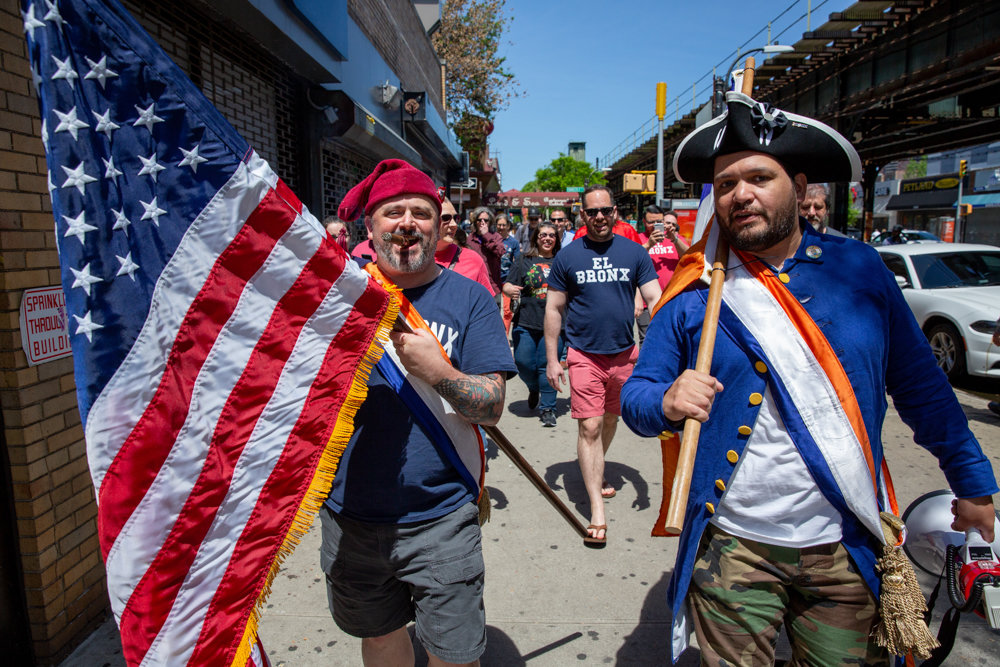Would-be liberators demand return of Marble Hill to its rightful borough
Bronx borough president James Lyons hopped into his limousine outside the Bronx County Courthouse and directed his chauffeur to make haste for Marble Hill. The time for invasion had come.
“Fuehrer Lyons, in quick foray, invades the ‘Sudetenland’ of Harlem and plants flag,” a New York Times headline from March 12, 1939 read, comparing the Bronx official to a certain central European autocrat who was annexing sovereign territory at that time. “Muttering residents are taken by surprise, and tanks at border are unmanned,” a Times secondary heading continued.
Lyons discovered four military tanks in an empty lot near West 230th Street and Kingsbridge Avenue, the border between the boroughs. Lyons climbs aboard one and “made a feeble and unsuccessful attempt to operate it,” according to the Times.
Lyons briefly claimed Marble Hill for the Bronx, but today it remains officially a part of Manhattan. Originally part of Manhattan’s physical island, the U.S. Army Corps of Engineers sliced Marble Hill off the northern tip during the construction of the Harlem River Ship Canal in 1895. Nearly two decades later, the Spuyten Duyvil Creek was filled in, connecting the neighborhood with the mainland — the Bronx mainland, that is.
Now, a group of local rabble-rousers and goofballs march on Marble Hill each year in Lyons’ memory, unofficially annexing the community into its “rightful” borough.
Yet, while residents there vote for Manhattan-based city leaders, the neighborhood itself is part of Bronx Community Board 8, is patrolled by the Bronx-serving 50th Precinct, and even has a 718 area code — a prime way to discover an outer-borough phone number.
The school district and postal ZIP code are all Bronx, too. Yet, Marble Hill residents serve their jury duty downtown, not off the Grand Concourse.
“The people of Marble Hill are blessed to be part of the Bronx,” said Isaac Moore, a Marble Hill resident and quasi-revolutionary. Since 2014, Moore and his group, the Great and Glorious Grand Army of the Bronx, meet at Mr. McGoo’s Pub on Broadway and West 231st Street for “pre-annexation libations” before taking “the hill” and then tactically withdrawing back to Mr. McGoo’s Pub for “post-annexation libations.”
This year’s invasion took place May 18.
Moore and buddy Angel Hernandez originally came up with the idea to stage the retaking while hanging out at Rosario’s Cigars in Kingsbridge and laughing about Lyons’ failed annexation of decades before.
“Angel and I, being smart alecks and history nerds, wanted to redo it,” Moore recalled.
Hernandez worked at the Bronx Historical Society at the time.
They wore tuxedos the first year, but lately the army’s outfits have taken on a more 18th century aesthetic. This year, Moore donned a tricorn hat, a blue coat, and a sash with stripes of orange, white and blue — the flag colors for the Bronx. Had it not been for his pants with a modern camouflage design or the bullhorn at his side, Moore would easily fit into George Washington’s army, who retreated through the area during the Revolutionary War.
Ruben Diaz Jr., the seventh official borough president since Lyons, is a supporter of the insurgency. Each year, as part of Bronx Week celebrations, Diaz encourages the annexation and heralds the unofficial Bronx army as heroes.
“Join the brave patriots of the Great and Grand Glorious Army of the Bronx today,” Diaz tweeted. Help them “reassert our borough’s ownership of Marble Hill!”
Diaz’s Manhattan counterpart, Gale Brewer, got in on the fun in 2014 telling the Daily News she was “happy to declare the flag that flies over Marble Hill is still that of the Manhattan archipelago.” Ever since, she’s kept quiet about the whole thing.
Moore jokingly speculates she’s concerned her acknowledgement will lend their efforts legitimacy, and the people of Marble Hill will rise up against their moneyed and self-important overlords.
“We get up there and we say things like, ‘Down with the effete bourgeoisies, up with cheap whiskey,’” said Moore, who likes to present the conflict as a struggle between stiff upper lip Manhattanites and industrious Bronxites. “The Bronx is the last vestige of working class New York City.”
Unfortunately for Moore and his compatriots, no one should expect Marble Hill to become part of the Bronx anytime soon. Since Bronx County was separated from New York County in 1914, borough borders have remained virtually unchanged. The closest they came to changing was in 1993 when a non-binding referendum for Staten Island’s secession from the city failed. Rudy Giuliani’s mayoral campaign promised to make the Staten Island Ferry free and close the Fresh Kills landfill, the at the time, the world’s largest landfill.
Besides, not everyone in Marble Hill is on board. Residents thumbed their noses and jeered at Lyons in 1939. In the 21st century, Lyons’ spiritual successors have their own share of adversarial behavior from the population they’re attempting to liberate.
“Usually there’s this old lady who lives (on Jacobus Place) who likes to swear at us every year,” Moore said. “She’s just like, ‘Go back to the (expletive) Bronx!’”















